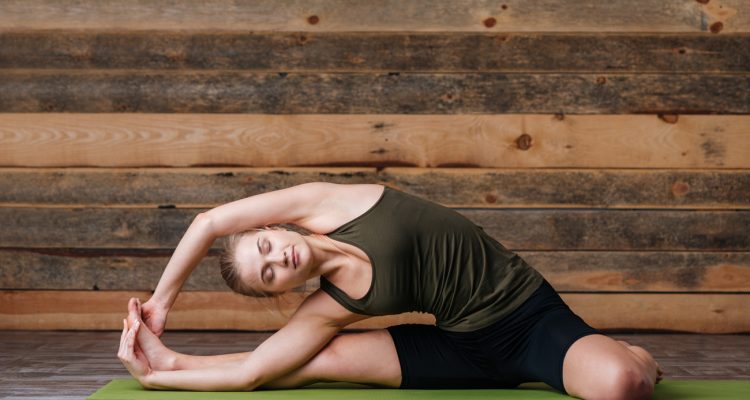Not long ago, I ran the Rock ‘n’ Roll Las Vegas Marathon. I skipped the first month of my training cycle because I had had some health issues that forced me to take a break from virtually all exercise. As soon as I got my doctor’s approval, I went directly into higher mileage training, jumping ahead to the middle of the marathon-training plan. Essentially I did everything you are not supposed to do. I did not cross train. I did not lift weights. I did not stretch. I was running 40-50 miles a week and did put in the time to do anything else. Because I had a strong base going into my break, I was not terribly worried. I was strong; I could run well over 50 miles a week. Who needs added strengthening, right? Wrong.
At the end of the 26.2 miles my legs were thrashed. Both knees were killing me and I was so tight, I could barely move. After a full 3-day recovery, I tried to run again. Pain. After a week of rest, I tried to run again. More pain. (Did I mention, how not smart I can be?) After steroid injections, weeks of physical therapy, and over a month of no running, I was somewhat back. I swore up and down I would do everything right from that point on. Luckily I have some good friends (who actually know what they are speaking about) give me some great advice on what to do in the future.
In April of this year, I was lucky enough to hear Kara Goucher speak at a race expo. She really stressed the importance of what she referred to as “prehab”, exercises meant to prevent an injury, instead of starting them after you are injured. Genius. Thanks to my change in attitude and a few changes in my training routine 2013 has been a much better and happier year.
STRETCHES
Tight muscles are a chronic and common issue for most runners. Flexibility is not usually a runner’s best attribute. A significant amount of research exists supporting static stretching after workouts as a means of injury prevention. Even if you don’t have time directly after a workout, doing these stretches regularly can make a huge difference in flexibility and how you feel.
Ankles: Ankles: Sitting comfortably in a chair, lift one leg slightly and point your toe. Starting with the letter “A, “draw each letter in the alphabet with your toe. Switch feet and repeat on the other side.
Heel Cord Stretch: Standing one foot away from a wall, place hands flat against the wall, with feet flat on the ground, shoulder width apart. Slowly bend knees as far as you can go, feeling the stretch through your Achilles. This is a great for runners with tight calves, Achilles issues, and plantar fasciitis. Option: Keep your feet parallel and shoulder width apart. Keep the knees straight and feet flat on the floor. Lean into the wall and let your back “sag”. Hold to a slow count to 5. Relax and repeat 5 times.
Hamstrings: Standing tall, extend your right leg in front of you with your heel on the ground. Slowly bend your left knee and lower your hips down, as if you were sitting in a chair. Keep the upper body tall and hold. Repeat on the other side. Option: Stretch while sitting. Sit with legs apart. Slowly reach for the right foot, until you feel the stretch in the hamstrings. Hold for a slow count to 10. Repeat on the other side.
Hip flexors/Quads: From a standing position, step forward with the left leg, as if you were performing a lunge. With the right knee touching the ground, the left knee should be directly above the left ankle. Keeping the upper body straight, push the hips forward, so the left knee is past the ankle. The right knee should be behind the hips. Repeat on the other side.
Gluteals: Lie flat on your back. Bend your right knee up with the right foot flat on the ground. Place your left ankle on the right knee, so that the right leg is perpendicular to the left leg. With your hands interlocked behind your right thigh, pull your right knee to the chest. Pull knee as close to the chest as you can comfortably. Repeat on the other side.
Back: Lie flat on your back. Placing your hands behind your thighs, bring your knees into your chest and hold.
STRENGTHENING
After my injury everyone told me I had weak hips and quads. A month of sitting out of races and fun practices made me realize how critical strengthening the core and legs really is. It helps improve form and muscle imbalance, and most importantly, prevents the dreaded i-word (injury, of course).
Planks: Planks are one of the very best strengthening exercises to target multiple muscle groups. They strengthen the abs, shoulders, back, and legs. The basic plank position is similar to a push up position, except your elbows are on the floor. Contract your abs to prevent your booty from sticking up or sinking. Your spine should be parallel to the floor, with your abs pulling toward the ceiling. Hold for one minute. Side planks are also awesome for the obliques, outer thighs, and glutes.
Crunches: Planks definitely help abdominal strength, but crunches can really isolate and target those muscles. The biggest thing to focus on when doing crunches is contracting the abdominals to pull your trunk up. You don’t need a huge range of motion, focusing on small movements from abdominal contraction, may only be a few inches. Work your way up to 3 sets of 25. Option: Sit on the floor with your legs slightly bent, holding a dumbbell in your hands. Lean your torso slightly back, until you feel your abs kick in. Rotate your shoulders and the dumbbell together, side-to-side for 20-30 reps. If you feel any lower back discomfort, discontinue.
Back extensions: On a comfortable surface, lie facedown, with most of your weight on your stomach. Extend your arms and legs, shoulder width apart. Contract your back muscles, so that both the arms and legs are off the floor, and hold for 2-3 seconds. Be careful not to hyperextend the neck. Repeat 15 times.
Single Leg Bridge: Lie on your back, knees bent, with one leg in the air, the other foot flat on the ground. Raise your hips up and down, squeezing your hamstrings and gluteals. Repeat 15-20 times and switch. These are excellent hamstring strengtheners.
Lateral Leg Raises: Lie on your right side, with legs extended and the body in a straight line. Slightly bend your right knee. Keeping the body straight, lift the left leg up and a few degrees posterior. Bring the leg down without touching the right leg. Repeat 15 times. Switch to the other side. Work up to 3 sets on each side. Challenge yourself: do the leg raise, and at the top do leg circles, keeping your foot rotated down. These are great for people with weak hips and IT band issues.
Squats: Squats can be done with weight or alone. They are wonderful for strengthening the quads, which can help prevent knee problems and help chronic knee pain. Standing tall, with legs slightly wider thank shoulder width apart. Keep back straight and chest out. Extend arms so they are parallel with the ground. Slowly sit back, as if you were going to sit in a chair,butt and chest out. Keep your knees above your ankles. Exhale and drive your weight into your heels to stand. Do not lock knees at the top of the squat. Repeat 25 times. Modification: Place a ball in between your knees while performing squats. This really works the medial aspect of the quadriceps, which protects the knee.
Wall sits: Lean your back against a stable wall. Keep your feet flat on the floor approximately two feet in front of the wall. Slide your back down the wall until your thighs are parallel with the floor, just as if you were seated in a chair. Hold for 1 minute.
Straight Leg Raises: Lie on your back. With your leg straight, and engaging the quads, slowly lift your right foot approximately one foot off the ground. Move laterally 30 degrees and return to center. Lower the leg without touching the ground. Repeat 15 times and switch legs. This is a great quad strengthener, but if you deal with sciatic nerve issues, you may want to stick with squats.
Please note, I am not a physician. If you are having joint pain or chronic problems related to running or workouts, go see your friendly orthopedic physician or favorite physical therapist.
Thanks to the following for all of their expert information: Brooke Wivholm, PA-C, Stephanie Riley, DPT, and Christine McConnelee, Certified Personal Trainer. Also, a big thank you to the photographed athlete who allowed us to photograph his perfect form!
More from Fit Nation:
Summer Running with Lianne: A Fit Nation Racing Blog
Crossfit: The Good, the Bad, and the Ugly

